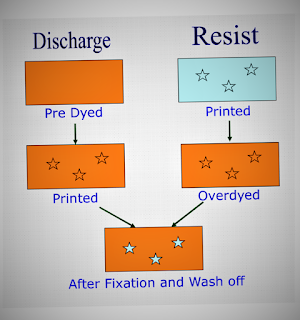What is Discharge Printing? |Resist Printing.:
 |
| Resist and Discharge printing |
Discharge Printing
It
is possible to speak of discharge printing, if in the fixation process that
follows the application of the printing paste there is local destruction of a
dye applied previously. If the etched (discharge), previously dyed area becomes
white, then the process is called white discharge.
If, on the contrary, a coloured pattern
has to be obtained in the etched area after the destruction of the previously
applied dye, then the process is called coloured discharge. In this case the
printing paste must contain a reduction-resistant dye along with the chemicals
needed to destroy the previous one. As a result the pre-dyed background is
destroyed according to a pattern and the dye, which is resistant to reduction,
takes its place.
Resist Printing
In the case of resist printing, a special printing paste (called resist) is printed onto certain areas of the fabric to prevent dye fixation. In the case of physical resist the material is printed with a difficult-to-wet resin that inhibits the penetration of a dye applied in a second stage. On the other hand, with a chemical resist, dye fixation is prevented by a chemical reaction. Depending on the way the process is carried out, one can speak of pre-printing, intermediate or over-printing resists. One common procedure is the wet-on-wet process in which the resist paste is initially printed, then the material is overprinted with full cover screen and finally fixed and washed. Over-printing resists can be applied only if the dye, already present in the previously dyed and dried fabric, is still in its unfixed form, as in the case of developing dyes.Dye Fixation:
After printing, the fabric is dried. Water evaporation leads to an increase in dye concentration and at the same time prevents the colors from smearing when the fabric is transported over the guide rollers. At this stage the dye is not yet fixed. The aim of the subsequent fixation step is to transport as much as possible of the dye, which is retained by the thickener, into the fibers. This is especially important with dyes, such as vat dyes, for example, that are printed in the insoluble form and are converted into the corresponding soluble state only after reaction with the reducing agents during the fixation process. Fixation is usually carried out with steam. Water vapour condenses on the printed material, swells up the thickener, heats the print and provides the necessary transport medium for the diffusion of the dye. The distribution of the dye between fiber and thickener is an important factor in determining the fixation degree of the dye, which is called the "retaining power" of the thickener. The thickener, in fact, is often composed of polysaccharides and therefore competes with cellulose in retaining the dye. This is the main reason why the fixation rate of a given dye is 10% lower in printing than in dyeing.
Textile Printing Operation
- At the end of each batch and at each colour change various cleaning operations are carried out
- The rubber belt, to which the fabric is glued during printing (see description below), is cleaned in continuous mode with water to remove excess adhesive and printing paste. Some machines are equipped with water re-circulation systems
- The printing gears (all systems responsible for feeding and applying the paste to the substrate) are cleaned by first removing as much as possible of the paste residues and then rinsing with water. In some companies the paste residues are directed back to the appropriate printing paste batch containers for re-use
- The remaining paste in the containers, in which the paste is prepared (paste vats), are in general previously cleaned up by means of sucking systems before being washed out with water. The residual printing paste collected in this manner is then disposed of.
Discharge Printing
Discharge printing
is a screen printing process where the same techniques and equipment are
used but instead of normal ink, discharge inks are used, which remove the
shirt’s dye instead of putting a color on top of the shirt. It is somewhat
similar to bleaching in a design, except it doesn’t damage the fibers like
bleaching would. It results in an extremely soft print, and shows the
weave of the shirt. It can be used by itself, as an underbase for other colors
to be put on top, or with pigments added. Pigmenting discharge can be difficult
to achieve exact color results, as the discharge efficacy affects the color,
and what you see is not what you get when mixing the pigments, but it can still
be a great way to achieve colors on dark garments.
Positives of
Discharge Screen Printing:
Very cool technique
that removes the dye from the shirt.
Little to no feeling
of the print on the shirt.
Vibrant colors.
The best way to
print on dark shirts with non-traditional inks.
Something different
from screen printing “norms.
Still able to do a
great amount of detail.
We offer discharge
printing at no additional charge. In fact, it’s often cheaper than traditional
ink because it takes less layers.
Negatives of
Discharge Screen Printing
·
Some styles may discharge
better than others.
·
Can be hard to use
for photographic style or process printing.
·
Only works on
natural fibers, like cotton, so 50/50 doesn’t discharge as well.
·
Not all shirt colors
will discharge (royal blue never works well, for example).
·
Process can be
quirky.
👇👇👇👇👇👇

0 comments:
Post a Comment